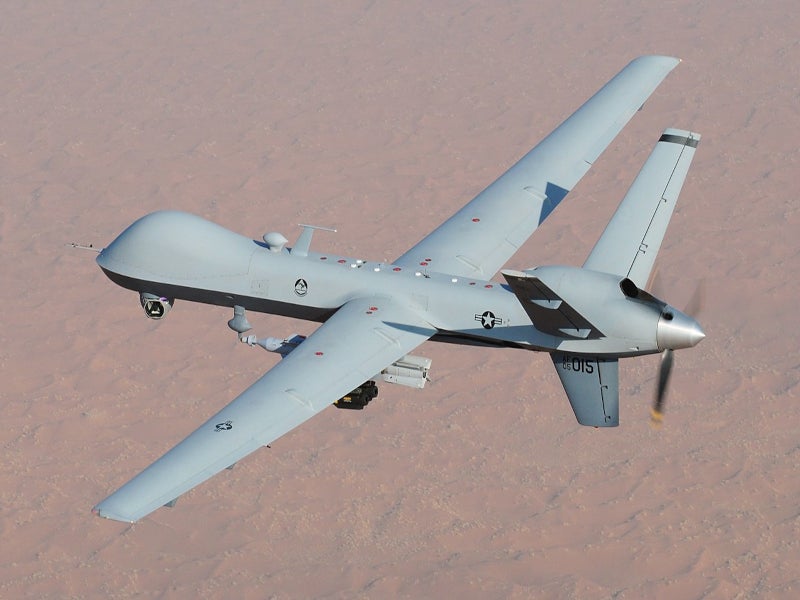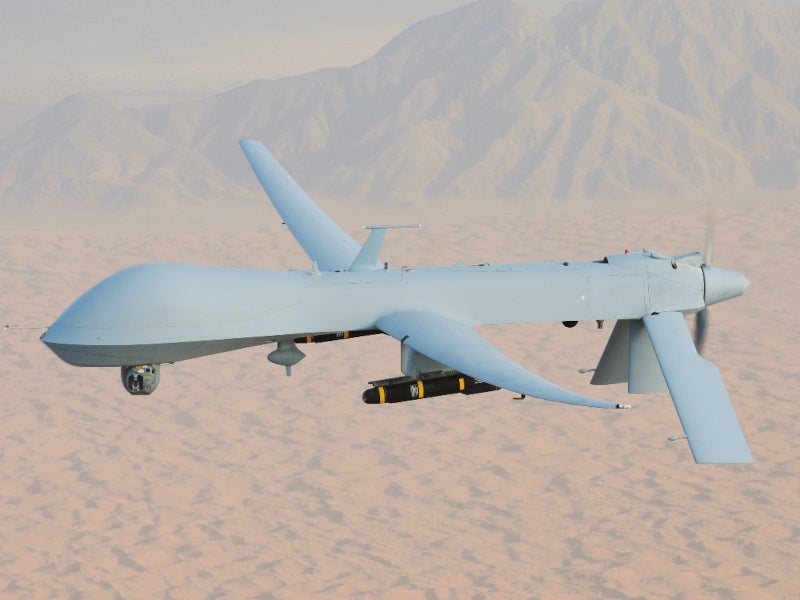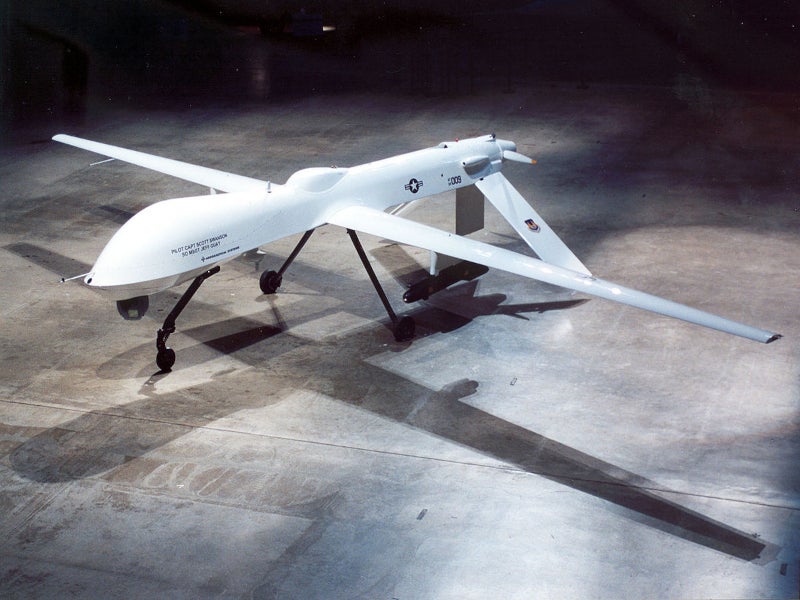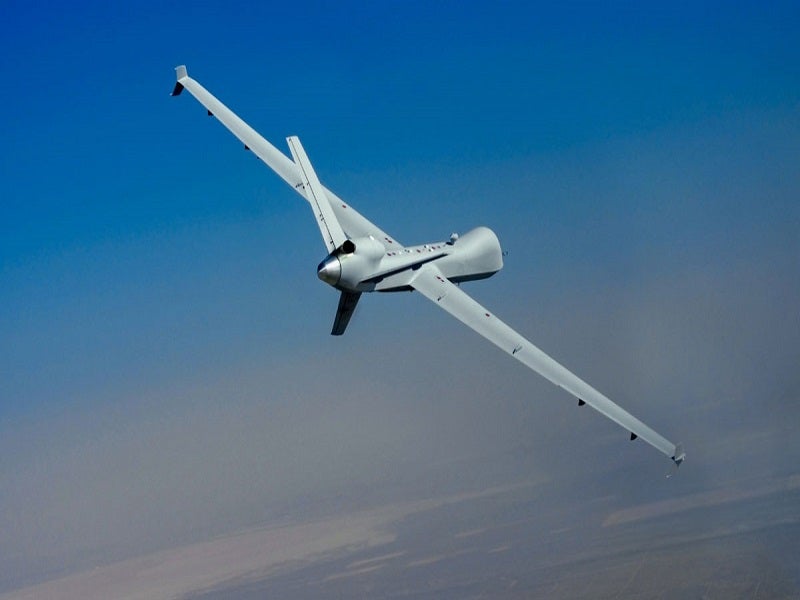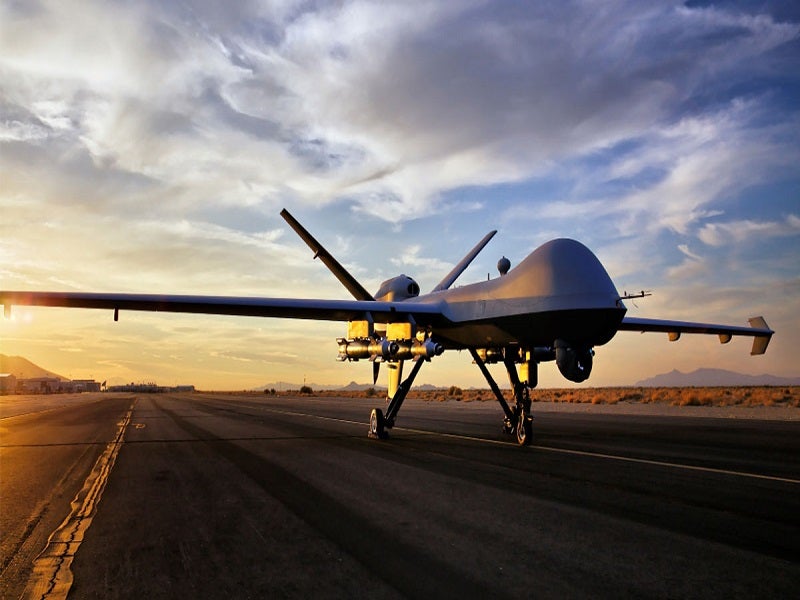The MQ-1, formerly designated as RQ-1 Predator, is a long-endurance, medium-altitude, turboprop-powered, multi-mission, unmanned aircraft system (UAS). It was manufactured by General Atomics Aeronautical Systems (GA-ASI), an aeronautics company based in the US.
A contract was awarded to GA-ASI in January 1994 to execute the Tier II, medium-altitude endurance Predator programme. The Predator system first flew in 1994 and entered production in August 1997.
The RQ-1 was designed for surveillance and reconnaissance missions. The designation was changed to MQ-1 in 2002.
Armed with AGM-114 Hellfire missiles, the MQ-1 is a multi-role platform used for armed reconnaissance and interdiction.
The UAS can distribute surveillance imagery from synthetic aperture radar, video cameras and a forward-looking infrared (FLIR) in real-time both to the front-line soldier and to the operational commander, or worldwide via satellite communication links.
GA-ASI received a contract from the US Navy to supply eight MQ-9A extended range (ER) UAVs for the US Marine Corps (USMC) in May 2022. The aircraft are expected to be delivered in late 2023.
System components of Predator UAV
A typical Predator system configuration includes four aircraft, one ground control system and one Trojan Spirit II data distribution terminal. The Predator air vehicle is 8.2m (27ft) long and has a 14.9m (49ft) wingspan. The system operates at an altitude of 7,620m (25,000ft) and at a range of 740.8km (400nm).
The endurance of the air vehicle is more than 40 hours, while the cruise speed is more than 129.6km/h (70kt). The air vehicle is equipped with ultra-high frequency (UHF) and very high frequency (VHF) radio relay links, a C-band line-of-sight data link, which has a range of 277.8km (150nm), and UHF and Ku-band satellite data links.Marine Corps (USMC) in May 2022. The aircraft are expected to be delivered in late 2023.
Predator UAV operation
Predator follows a conventional launch sequence from a semi-prepared surface under direct line-of-sight control. The take-off and landing length is typically 609.6m (2,000ft). The mission can be controlled through line-of-site data links or through Ku-band satellite links to produce continuous video.
Video signals received in the ground control station are passed to the Trojan Spirit van for worldwide intelligence distribution or directly to operational users via a commercial global broadcast system. Command users are able to task the payload operator in real-time for images or video on demand.
Predator B Skywarrior
In May 1998, General Atomics, the parent company of GA-ASI, was awarded a Block 1 upgrade contract to expand the capabilities of the Predator system. System upgrades included the development of an improved relief-on-station (ROS) system which allows continuous coverage over areas of interest without any loss of time on station, secure air traffic control voice relay, Ku-band satellite tuning and the implementation of an air force mission support system (AFMSS).
The upgrade also covered a more powerful turbocharged engine and wing de-icing systems to enable year-round operations.
In August 2005, a version of Predator B called Sky Warrior was chosen for the four-year system development and demonstration (SDD) phase of the US Army’s extended range / multi-purpose (ER / MP) UAV programme, comprising 11 Sky Warrior systems, each with 12 air vehicles and five ground control stations.
The initial operating capability was achieved in 2009, while two Block 0 Sky Warrior UAVs were deployed to Iraq in April 2008. GA-ASI received $195.5m in funding from the US Army for the low-rate initial production of the Sky Warrior unmanned aircraft in July 2010.
The US Department of Homeland Security / Customs and Border Protection (DHS / CBP) ordered two Predator B systems for monitoring of the US’ south-west border, in August 2005.
The first was delivered in late 2005, the second in September 2006. Two more systems were ordered in October 2006, for monitoring operations on the border with Canada.
MQ-9 Reaper Hunter / Killer UAV
The USAF awarded a further contract for the system design and development (SDD) of MQ-9 Reaper Hunter / Killer in March 2005. It placed orders for 21 MQ-9s, while eight aircraft were initially delivered to the USAF.
The first USAF MQ-9 squadron, the 42nd Attack Squadron, was formed in March 2007, based at Creech AFB in Nevada.
The USAF first deployed the MQ-9 Reaper to Afghanistan in October 2007 for precision airstrikes. The MQ-9 Reaper flew its first operational mission in Iraq in July 2008.
The MQ-9 Reaper has an operational ceiling of 15,240m (50,000ft), a maximum internal payload of 362.8kg (800lb) and external payload exceeding 1,360.7kg (3,000lb). It can carry up to four Hellfire II anti-armour missiles and two laser-guided bombs (GBU-12 or EGBU-12) and 226.8kg (500lb) GBU-38 JDAM (joint direct attack munition).
In May 2008, a USAF Reaper successfully test dropped four Raytheon GBU-49 Enhanced Paveway II 226.8kg (500lb) bombs, which have laser and GPS guidance.
The MQ-9 sensor payload can include the General Atomics Lynx SAR (synthetic aperture radar). Lynx also features ground moving target indicator technology.
GA-ASI developed and demonstrated three expanded automatic take-off and landing capability (ATLC) improvements for the MQ-9A platform in June 2020.
The USAF deployed the MQ-9 Reapers to Romania to carry out intelligence, surveillance and reconnaissance (ISR) missions in support of Nato operations in January 2021.
An MQ-9 equipped with the Reaper Defense Electronic Support System (RDESS) was flown by the USAF’s 26th Weapons Squadron (WPS) for the first time in April 2021. The RDESS, which is a broad spectrum, passive electronic support measure (ESM) payload, can improve the capability of the aircraft by collecting and geo-locating relevant signals from a stand-off distance.
MQ-1 / 9 Predator payload details
The surveillance and reconnaissance payload capacity is 204kg (450lb) and the vehicle carries electro-optical and infrared cameras and a synthetic aperture radar. The two-colour DLTV television is equipped with a variable zoom and 955mm Spotter, while the high-resolution FLIR has six fields of view ranging from 19mm and 560mm.
The Raytheon multi-spectral targeting system (MTS-A) is fitted on the MQ-1 / 9 Predator. The MTS-A provides real-time imagery selectable between infrared and day TV, as well as a laser designation capability. MQ-1 can employ two laser-guided Hellfire anti-armour missiles with the MTS.
Providing all-weather surveillance capability, the Northrop Grumman TESAR synthetic aperture radar is fitted on the MQ-1 and has a resolution of 0.30m (1ft). Other payload options, which can be selected to meet mission requirements, include a laser designator and rangefinder, electronic support and countermeasures and a moving target indicator (MTI).
The USAF equipped a number of MQ-1 and MQ-9 Predators with a version of the Northrop Grumman airborne signals intelligence payload (ASIP) in 2010. Northrop Grumman was awarded a contract for the development and flight testing of the system on an MQ-1 in April 2008. ASIP was also tested on the U-2 reconnaissance aircraft and fitted on the RQ-4 Global Hawk.
MQ-9A Block 5 configuration
The MQ-9A Block 5 can operate continuously for 27 hours at an altitude of up to 15,240m (50,000ft) and speeds of approximately 444.48km/h (240kt). It can carry payloads weighing up to 1,746kg (3,850lb) including 136kg (300lb) of external stores.
The Block 5 configuration is designed to provide longer endurance and is equipped with full motion video and synthetic aperture radar/maritime radar/moving target indicator to provide continuous surveillance capability. It features the latest versions of the GA-ASI Lynx® multi-mode radar and Raytheon electro-optical sensors. Additionally, the Block 5 variant incorporates a fault-tolerant flight control system and a triple redundant avionics system architecture.
GA-ASI announced the integration of the Leonardo Seaspray 7500E V2 multi-mode radar onto the MQ-9A Block 5 UAS and the first flight in April 2022.
Ground control station
A UAV ground control station is built into a single 9.1m (30ft) trailer, containing pilot and payload operator consoles, three Boeing data exploitation and mission planning consoles and two synthetic aperture radar workstations together with satellite and line-of-sight ground data terminals.
The station can send imagery data via a landline to the operational users or to the Trojan Spirit data distribution system which is equipped with a 5.5m dish for Ku-band ground data terminal and a 2.4m dish for data dissemination.
Contractors involved
General Atomics is the prime contractor of the Predator UAV.
The main subcontractors for the project include Versatron / Wescam for the electro-optical Skyball Gimbal, Northrop Grumman for the synthetic aperture radar, L3 Communications, which was renamed L3 Technologies and merged with Harris to form L3Harris Technologies, for the wideband satellite communications link, and Boeing for the intelligence workstation and mission planning system.
Orders and deliveries of MQ-9 Reaper
GA-ASI holds export licenses to sell an unarmed export version of the Predator drone to Saudi Arabia, Egypt, UAE and Morocco.
The UK requested the foreign military sale (FMS) of two MQ-9 Reaper systems with Lynx SAR, multi-spectral targeting systems and one ground station in September 2006. Deliveries began in mid-2007 and the Royal Air Force (RAF) deployed the system in Afghanistan in November 2007. In January 2008, the UK requested the sale of ten additional MQ-9 systems.
In June 2015, the Italian Directorate for Air Armaments and Airworthiness (DAAA) selected CAE to develop upgrades to a Predator UAS Mission Trainer for the Predator A and Predator B / MQ-9 aircraft developed for the Italian Air Force. The new trainer was inducted into the air force in February 2018. GA-ASI received a contract from the Italian Air Force to provide the mid-life update for its MQ-9 fleet, modernising them to the Block 5 configuration.
GA-ASI received a $30.5m contract to upgrade the Italian Air Force’s (IAF) MQ-9A Predator B drones from Block 1 to Block 5 standard, in September 2021.
The company was contracted to deliver MQ-9 systems to the Royal Netherlands Air Force (RNLAF), in July 2018.
Spain placed an order for two MQ-9 UAVs in April 2019. The first system was delivered to the Spanish Air Force in December 2019. The final two MQ-9A Block 5 Reapers and a ground control station (GCS) were delivered to Spanish Air Force in November 2020, as part of an FMS agreement to supply four aircraft and three ground control stations.
GA-ASI was selected by the Australian Department of Defence (DoD) for the supply of a MALE RPA through a competition, in November 2018. Australia preferred the MQ-9B SkyGuardian over the MQ-9 Reaper for its MALE RPA requirement in November 2019. Australia cancelled the procurement plans for the MQ-9B aircraft in March 2022. The reasons for the cancellation, however, were not disclosed.
The company received the Agile Reaper Enterprise Solution (ARES) contract with a $7.4bn ceiling value from the US Air Force Life Cycle Management Center’s MQ-9 Program Office in September 2020. The five-year contract aims to reduce the time to deliver MQ-9s to operational units and allows for the procurement of up to 36 aircraft a year.
The US State Department approved the UAE’s request to purchase 18 MQ-9 Reaper drones in November 2020.
In July 2021, the company rolled out the first MQ-9A RPA and ground control station for the Royal Netherlands Air Force (RNLAF). The aircraft underwent acceptance testing. GA-ASI was contracted to deliver four MQ-9A Block 5 aircraft and four ground control stations to the Netherlands under an FMS agreement with the US. The contract also includes the delivery of associated equipment support.
The first three MQ-9A Block 5 aircraft and two mobile ground control stations were delivered to the RNLAF in April 2022.
The US Government approved follow-on support for the French MQ-9 aircraft in February 2022.
Predator UAV operations and deployments
Predators were operational with the 11th and 15th Reconnaissance Squadrons of the US Air Force (USAF). A total of 268 Predators were delivered to the USAF, with the final delivery completed in March 2011. The Italian Air Force ordered six Predator unmanned aerial vehicles (UAVs). The Italian drones were deployed to Iraq in January 2005. GA-ASI delivered the final two UAVs to the Italian Air Force in 2015.
Predator UAVs were operational in Bosnia in support of NATO, UN, and US operations. The unmanned systems were also deployed as part of Operation Enduring Freedom in Afghanistan and Operation Iraqi Freedom. The MQ-1 Predator achieved initial operating capability (IOC) in February 2005.
In February 2001, the Hellfire-C laser-guided missile was successfully fired from a Predator air vehicle in flight tests at Nellis Air Force Base, Nevada. A Predator UAV was used to drop a Hellfire missile in Yemen in November 2002, destroying a civilian vehicle carrying suspected terrorists. In August 2002, a Northrop Grumman Bat submunition was successfully dropped and a FINDER mini-UAV launched from a Predator UAV.
The USAF ordered 36 additional MQ-1B Predators equipped with Hellfire missile installation kits in September 2007. The USAF accepted the final MQ-1 Predator aircraft in March 2011.
In 2011, GA-ASI signed two separate agreements with CAE and RUAG International’s RUAG Aerospace Services to provide the Predator B UAS to Canada and the Federal Republic of Germany respectively. RUAG International, a subsidiary of RUAG International Holding, sold RUAG Aerospace Services to General Atomics Europe in March 2021.
GA-ASI signed a memorandum of understanding with Fokker Technologies, part of GKN Aerospace, in June 2013 to offer the Predator B RPA to support the Dutch Government’s medium-altitude long-endurance (MALE) capabilities. It also partnered with Spanish engineering company SENER to provide Predator B RPA to the Spanish Government in March 2015.
In May 2014, GA-ASI and Rohde & Schwarz (R&S) partnered to integrate R&S’ air traffic control radios on the Predator aircraft. A pre-production due regard radar (DRR) was tested onboard the Predator B RPA in February 2015.
The USAF fielded the MQ-9 Reaper extended range (Reaper ER) in August 2015. The Reaper ER provides increased range and endurance. It comes with field-retrofittable capabilities such as two wing-borne fuel tanks. It is fitted with an alcohol/water injection system and a four-bladed propeller to enhance thrust and take-off performance. A heavyweight trailing arm landing gear system is also incorporated for safe ground operations.
GA-ASI delivered three Predator B/MQ-9 Reaper systems to the French Ministry of Defence in May 2015. France placed a $123m order with GA-ASI for the 3rd / 4th systems of MQ-9 Block 5 programme in August 2018.
The Predator UAV fleet was retired from the USAF’s service in March 2018. The MQ-9 Reaper has been serving as the USAF’s primary remotely piloted aircraft for offensive operations since 2018.

